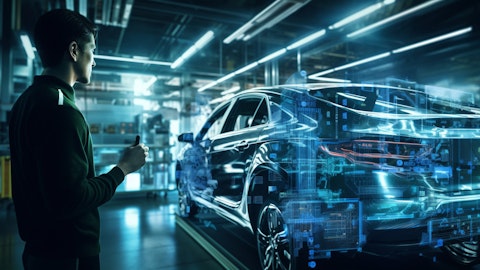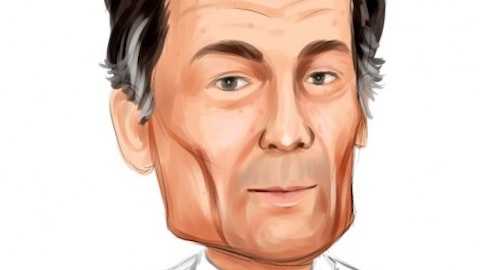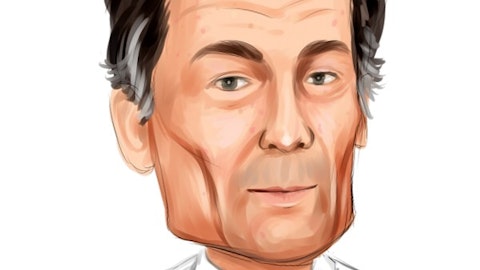And I would say we didn’t lose anything that we wanted to win. That wasn’t the reason for the order book mix. It was all just decision-making that was supposed to happen by ’23 being deferred in the ’24.
Itay Michaeli: Terrific. Very, very helpful. Thank you.
Austin Russell: Yes, absolutely. And I will say that when it comes to product planning cycles in programs, part of the whole point is that there’s a relatively limited, like there’s only so many automakers that are early adopters of something. You know that’s part of the reason why a lot of this stuff is super lumpy as well along the way. And I think like I said, as you said, we won everything we wanted to win this past year. The thing is that when it comes to product cycles for this, the way that we’re kind of thinking about the roadmap side of it is a new kind of step function improvement in product every sort of three years to four years. I know a lot of times in just certain industries, we’ll have like one-year to two-year product cycles, but that’s not particularly useful in automotive because you have seven-year-long program spans.
And even then, you really want to be able to best leverage the economies of scale and supply chain. So that’s of course, for the next-gen stuff, that’s what I’m really excited to be able to unveil at Luminar Day, given that the work that we’ve done for what, like five years now on the back end for this next-generation technology development, and that’s where the transformation can happen of whereas Iris, like an Iris+, it’s great for what’s there. Tom mentioned what now. It’s scaled up to ’25 vehicle models and programs with that, but that’s something that goes like 100,000 millions’ or whatever with the next generation. That’s where you could ultimately see this being on mainstream vehicles. It’s capable of being on tens of millions of vehicles and scaling accordingly.
So that’s really the breakthrough objective that we have ahead. But we’ll share the details at Luminar Day.
Itay Michaeli: Thank you. Appreciate all the detail.
Aileen Smith: All right, we’re going to take a few questions from the SAFE community. First one, how will the company offset the loss of business for autonomous vehicles as the need appears to be shrinking and not growing? Are you planning for growth or planning for sustainability?
Tom Fenimore: We’re planning for both. When you look at the order book and what we’ve calculated that, and you kind of look at autonomous robo-taxis, I think there’s a few million dollars, so less than 1% in our order book, and that’s simply from POs that we have in hand for this year. And so our order book is almost in the passenger vehicle and consumer space. That is a bet that Austin made several years ago to focus on that if and when robo-taxis get here in the near future. That’s great. That is all upside to our order book as well as our near and medium-term growth.
Austin Russell: Absolutely. And I would say not only that, is that the kind of stuff that and this is oftentimes very much confused with Luminar and obviously part of the frustration as it relates the broader industry sometimes we get painted with the same brush. But not only is some of this floundering they’ve had, not that doesn’t affect any portion of the business because we didn’t have any of that, we’ve had the focus for production vehicles the whole time and it actually is further validating of our thesis that we made the right moves in this and that’s why also we’re able to lead the charge, a relatively small company like Luminar shouldn’t have won out over the Waymos, and Cruises, and Aurora’s, and Apple’s and all this other stuff of the world to be able to be first to a global production vehicle with this kind of technology doesn’t make sense.
So the reason why it just comes down to the right technology, the right strategy, the right bets, the right capabilities that we’re building from a full stack standpoint. And obviously, the goal is to have that validated where we can get separated from that pack of autonomous vehicles, companies that maybe haven’t been as successful and really show how we can be more, as I said, like those other kinds of growth, tech comparable companies that I mentioned earlier.
Tom Fenimore: What do we got next, Aileen?
Aileen Smith: Our second question is, is the higher cost of implementing Lidar the reason behind as to why car companies are holding back on LiDAR? If so, do you see this technology becoming cost-effective in the future, to be widely considered by most car manufacturers?
Tom Fenimore: Yes, look, I think we’re there today, particularly with our next-gen product, where as I mentioned, we’re going to be taking the cost down. And so, look, our customers are always going to ask for lower pricing, but we’ve been able to commercialize and industrialize our initial product with Iris to get it on vehicles starting here imminently now, albeit it tends to be at the higher price point, which is very consistent with the introduction of any new technology. But I would say while our OEMs customers are always going to beat up on cost, that is not really what I would say is an obstacle for us winning more business, particularly with our next-gen product.
Aileen Smith: Yes. Absolutely. And I would say the biggest barrier is just the natural adoption cycles that we talked about earlier. It just takes time for new people platforms to come out and to get adopted. And the reality is that folks like, particularly, in particular, Volvo is always the first to introduce new kinds of safety technologies. Mercedes is generally the first to introduce new kinds of other advanced technologies. We’re working with both of those know to be able to make that happen to production, show the industry what’s possible, and then it trickles down from there.
Aileen Smith: Okay, we’re going to switch back to our analyst community. Our next question is going to come from Kevin Cassidy at Rosenblatt.
Kevin Cassidy: Yes, thanks for taking my question. And it was right along the same lines, Austin and Tom, what you were just saying. I want to understand more about the next-gen product. And the market that you’re addressing with that, how much larger is it? How many more bids are you looking at than compared to the early adopters, I just want to see where the momentum is.
Tom Fenimore: I would say that. So if you take a look at our opportunity on this, like I said, I think we’re kind of within this same realm and world with Iris and Iris+, the next-gen product that unlocks, I would say probably at least another order of magnitude of volume opportunity, maybe more. I mean, arguably there’s actually already an order of magnitude, additional volume opportunity even with just our existing customers on LiDAR alone, much less new customers. So I think this is where we see this as a big opportunity to drive further adoption throughout the industry. I think also, though, that the most critical part of all this is all going to be about the recognition of value. Right now, I think LiDAR is cool, it’s seen as important, but it doesn’t yet have the status of what sort of Volvo has called as kind of the 21st-century seatbelt and that’s where we want to be able to get to.
So that this is truly a standardized technology across the industry and there’s frankly no reason why that can’t happen. The key is just showing also the safety benefits. And that’s why I had mentioned that we’ve been collaborating with these third parties to provide our technology to them for testing that’s being independently run to be able to quantify the safety benefits of what can be had on vehicles and we have a host of different automakers that are actually extremely interested in the results of this comprehensively as it relates to their product planning. And for that matter, insurance companies too, for that matter, when it comes to the safety benefits and improvements which directly affects this and that’s why when you talk about the long-term benefits of this.
You’re talking about thousands of dollars of value and savings being added for every LiDAR put onto a vehicle, assuming any kind of material safety improvement and savings when you take a look at a total cost of ownership perspective. So that’s where we need to get to. It just needs to be a broader recognition of value as well. But it also takes, of course, the product to be scalable to do that. And that’s where one of the milestones that we have for the here, in addition to scaling up the factory that we have down in Mexico. We’re also getting our next, also high-capacity factory online as well to support additional production with TPK.
Kevin Cassidy: Great. Maybe just as a follow-up, you hit on a couple of points there. Right now, the buyer, when he’s buying the Volvo car, is it an option for him to put in a Luminar LiDAR, or is it standard?
Austin Russell: Standard.
Kevin Cassidy: Standard. Okay, that’s great. Okay, thank you.
Aileen Smith: Our next question will come from Kevin Garrigan at WestPark.
Tom Fenimore: Hey, Kevin.
Kevin Garrigan: Hey, Tom. Hey, Austin. How’s it going?
Austin Russell: Good.
Kevin Garrigan: Thanks for letting me ask a question. So, I guess, I’m just kind of wondering if you can talk about the progress that you’ve made with Civil Maps. I mean, one of the U.S. automotive OEMs recently talked about continuing to use LiDAR for mapping. So kind of wondering if that’s becoming more of a talking point in your discussions with OEMs than maybe it was six months ago and is that kind of put you at an advantage compared to others that are fighting for the same RFI or RFQ.
Tom Fenimore: Absolutely. It’s like, it’s just. I like to describe it as value created in the ecosystem by our LiDAR. Austin just mentioned the safety improvements, which manifests itself in the insurance saving. The other Kevin, before you just asked if we’re an option or standard, there is for a lot of the customers we’re talking to, it’s an option for l three or certain levels of autonomy, which the consumer has demonstrated a willingness and ability to pay for and for here you’re going to have a lot of vehicles that are going to be driving around collecting 3D data, which is a very useful tool to map the environment around you. And so we want to work with our OEMs, and we’re having conversations with them as about how you can capture that and monetize it, because ultimately, the more value we can create with our LiDAR, the more willingness that they are to buy it.
And as I mentioned earlier, beat us less up on price because they’re going to look at the value created in the ecosystem, and the more tools we provide them to do that, the better it’s going to be. So I’m not going to go into much more detail now, but yes, we are getting good commercial traction on the mapping side, and it’s another tool in the arsenal when we go in and have those strategic and commercial conversations with our customers.
Austin Russell: We’ll share more on Luminar Day.
Kevin Garrigan: Got it. Okay, perfect. Thank you for that. And then, just as a follow-up, can you talk a little bit about how things are going with Nissan, I mean, are things on track with what you’ve been expecting? Are things taking longer? Is Nissan kind of waiting for the next-gen, LiDAR, any update there would be great.
Tom Fenimore: No. Look, they’re continuing to move forward. As a reminder, Nissan, we’re at a development contract that at some point in the future is going to convert into serious production. We’re very confident of that. We’re continuing to move forward on the development side. As I mentioned during the last earnings call, that kind of moved into the next stage of the development contract. As a reminder, right now we have zero in the order book for Nissan. And the reason for that is they really haven’t converted that from a development contract to a series production contract you know and that’s one of those things that is ultimately out of our control. It’s going to be dictated by Nissex product planning and when they’re ultimately ready to start putting that on series production awards, I think that is going to happen soon.
They’re working with a version of Iris. They’re not waiting for the next-gen product, although as you can imagine, I think they’re very excited about it. And I would say. that we’re in discussions with them about how we can grow within the Luminar ecosystem in addition to just LiDAR there. So that’s continue to move forward. That’s going well but hasn’t converted into that series production award yet, which is a trigger where we put it in the order book.
Kevin Garrigan: Yes, got it. Okay, perfect. Thanks, guys.
Aileen Smith: Our next question will come from Mark Delaney at Goldman Sachs.
Austin Russell: Hey, Mark.
Mark Delaney: Good afternoon. Thank you very much for taking the questions. The company noted that a double-digit percent of revenue is coming from non-LiDAR hardware sales already. Can you detail where Luminar has had the most success so far and how do you see these efforts progressing in areas like insurance, software, and semiconductors? And then to what extent are these business adjacencies still ones you want to pursue if you are trying to be more cost-optimized?
Tom Fenimore: Look a very good question. I think you kind of answered your own question where it’s kind of like all of the above, right? We do have sales from Luminar Semiconductor which actually provides some of the critical components to our LiDAR. There are sales from that. I would say there are some sales, not big in there for software, but it’s more development work we’re doing as opposed to actually selling it in, like, I man in serious production scale. So it’s more for development work that we’re looking to do. There isn’t, I would say, anything material in there for insurance yet. And then you know, we are looking to, there are some sales in there in terms of monetizing some of the information we gather, and we kind of used mapping like that as well.
And so we are making progress on that. It is, I would say, a material part of our revenue. But in the near term, Mark, what’s really going to drive our revenue growth this year is getting the series production with Volvo and selling our LiDAR to them. One of the things we are hoping to do, and it’s one of the business milestones we set out this year is to expand. I would say that ecosystem around our LiDAR even more, and manifesting that into the equivalent of serious production winds.
Mark Delaney: My other question…
Austin Russell: I was going to say also on the topic there too, in particular for the Luminar AI engine that we announced at Luminar Day last year. You know that’s been a huge driver as well in being able to realize success of the ecosystem. So that’s a critical part of that. I think, like I said, we’re going to outline more of the details around the ecosystem at Luminar Day, in particular. But to Tom’s point, I think we think the most, we actually haven’t counted any, like a lot of that stuff as well in the order book, for example, there’s no semiconductors in an order book, none of that stuff because there’s a lot of nuance to it. So, I think we can provide more detail on that. But it’s also important like when you talk about the incremental cost, a lot of the stuff that we’re talking about in terms of the long-term work, like I would say even as it relates to LiDAR and industrialization, historically, we may have been a lot more open to doing product customizations for certain types of customers and like autonomous vehicle companies and robo-truck companies out there, for example.
And these have — those do have real cost. And like when the revenue opportunity is like probably in the same vicinity as the cost of what it takes to actually do that and execute that at best, then you obviously have to question those things, and obviously you’re making it upfront. So I think that there’s a lot of lower hanging fruit as well that we can do where I would say probably 80% to 90% of the value is in, probably more than 90% of the value is in the top, like 50% of the initiatives that we have. So that’s where we can just, we can work the dial on that as well, to be more conservative or more aggressive, depending on how much we want to spend. And obviously, we are starting this year, as I mentioned earlier, we’re going to lean much more toward the conservative end of that spectrum.
Mark Delaney: Very helpful. Thanks. And my other question was just about one of your objectives for this year, which is to pass the final run-at-rate test for the EX90. Maybe you can talk about what steps Luminar still needs to achieve in order to be ready to pass that final run-at-rate test. And what’s different from the run-at-rate test you had talked about passing on the last quarterly call? Thank you.




